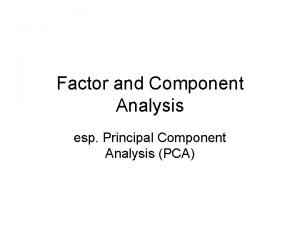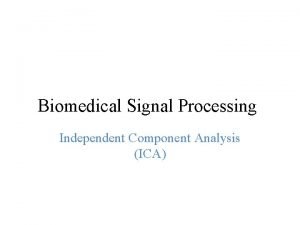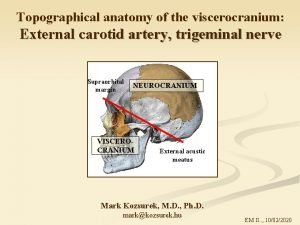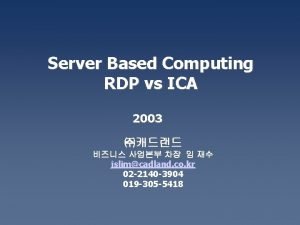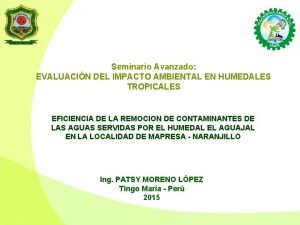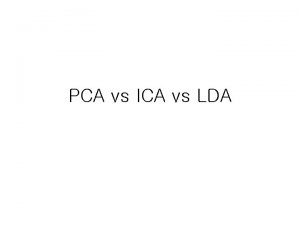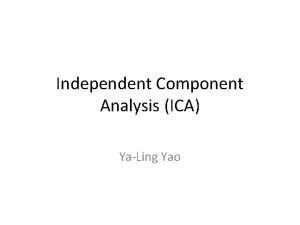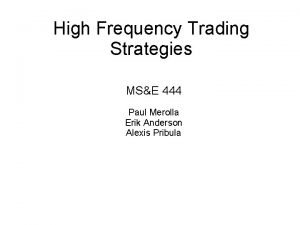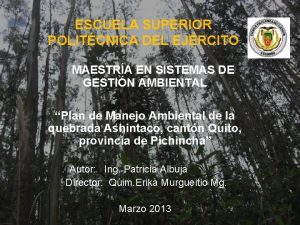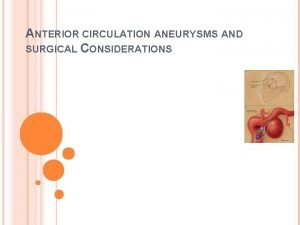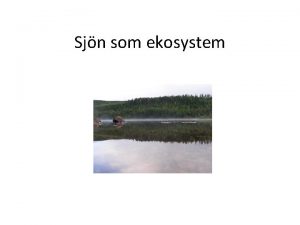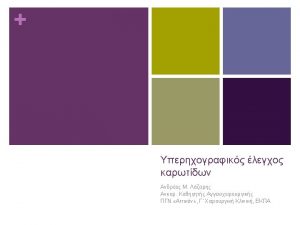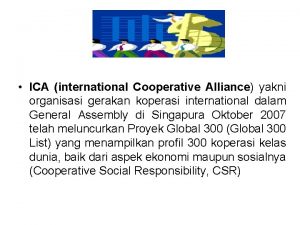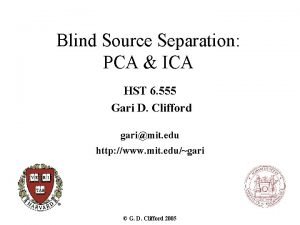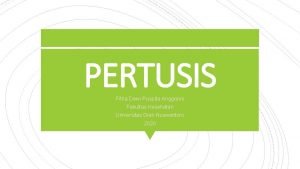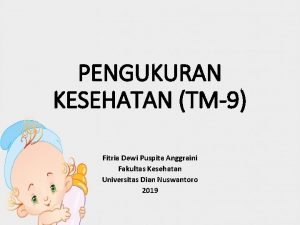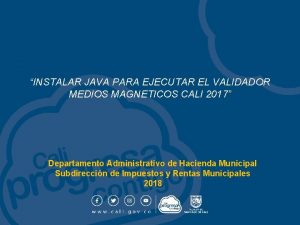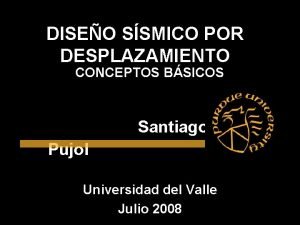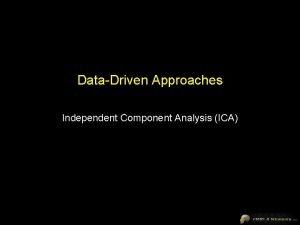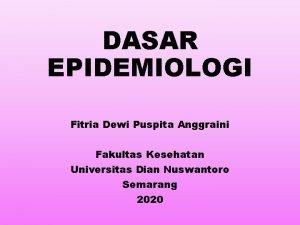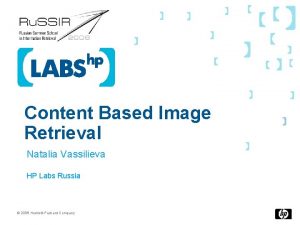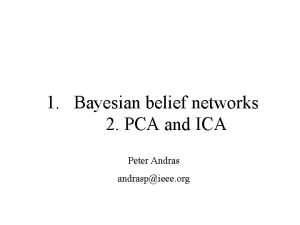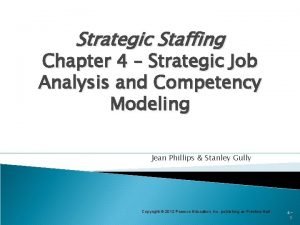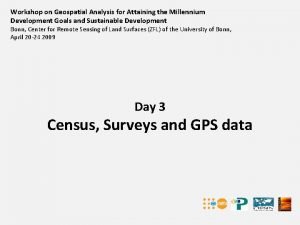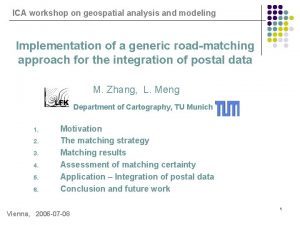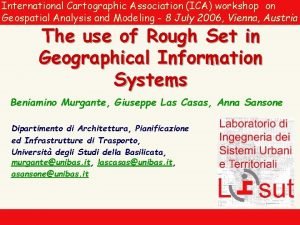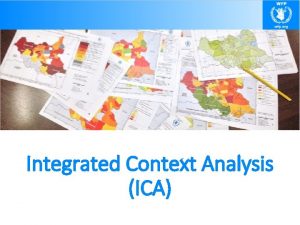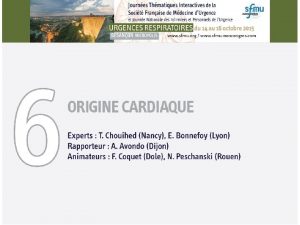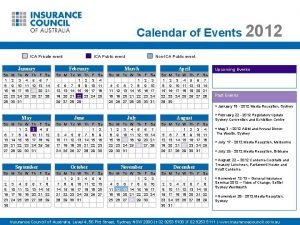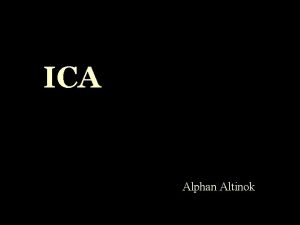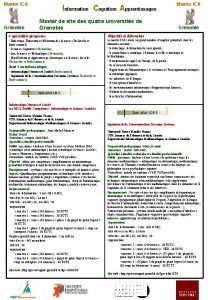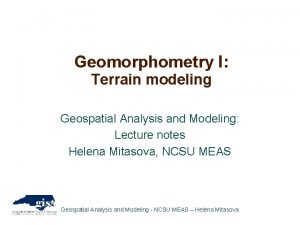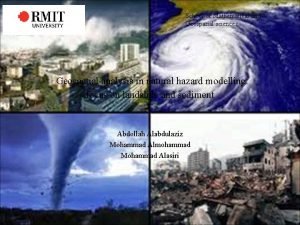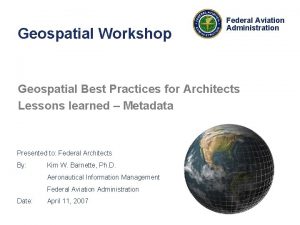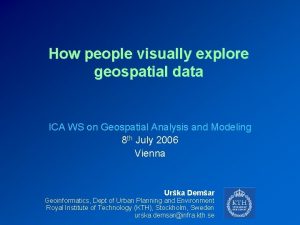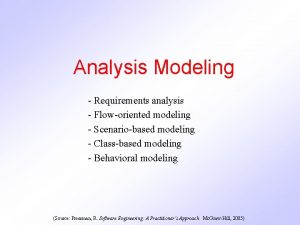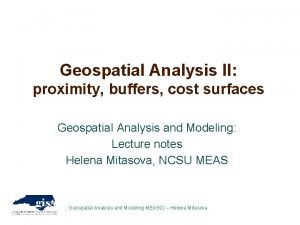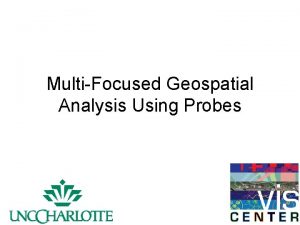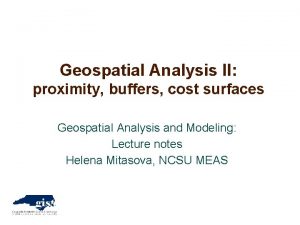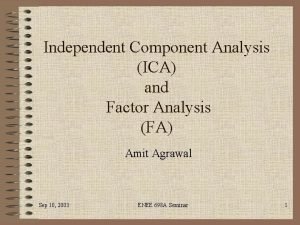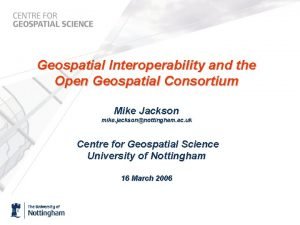ICA Workshop on Geospatial Analysis and Modeling 8




































- Slides: 36

ICA Workshop on Geospatial Analysis and Modeling 8 July 2006 Vienna A TOOL PERFORMING TOPOLOGICAL CORRECTION IN GIS Eva Savina Malinverni - Università Politecnica delle Marche - Ancona (Italy) e. s. malinverni@univpm. it Stefano Bellesi - Regione Marche - Ancona (Italy) stefano. bellesi@regione. marche. it

GENERALITY THE GIS DATA STRUCTURE THE DATA MAINTENANCE APPLICATIONS

TOPICS ANALYSIS OF THE TOPOLOGICAL INCONSISTENCY IN SPATIAL DATABASES COMING FROM NUMERICAL CARTOGRAPHY ORGANIZED IN INFORMATIVE LAYERS GENERALIZATION IN THE GIS PRESERVING THE CORRESPONDENCES AND THE DATA STRUCTURES IMPLEMENTATION OF A NEW TOOL “TOPOLOGY ” IN A COMMERCIAL SOFTWARE TO SOLVE SOME TOPOLOGICAL PROBLEMS

TYPOLOGIES OF DATA STRUCTURES n VECTOR MODEL: objects which have a position in the space (2 D-3 D) n TOPOLOGY: spatial relationships among the objects (2 D) n ATTRIBUTE: the description of the objects However ……the spatial relations, typically derived from positional information, are often imprecise and they can produce some results in conflict with the geometric representation of the real objects…. . .

VECTOR MODEL “NON -TOPOLOGICAL” MODEL The vector model is the most natural computer graphic translation of real objects §Every object is represented by a single entity §Every entity is represented by a single primitive §It is possible to have duplicated primitives Disadvantages: n n Redundancies Incongruities in the sense that object-face relationships are not preserved

TOPOLOGICAL MODEL • There are not primitives parzially or totally overlapped • It needs to divide the entities according to the primitives The topological model repeats the traditional drawing in cartography • Different entities can share the same primitives • This type of data manipulation involves concepts such as adjacency, connectivity and containment Advantages: THE SPATIAL RELATIONSHIPS PLAY AN IMPORTANT ROLE IN THE SPATIAL DATABASE, SINCE THEY ARE USUALLY THE BASE FOR A CORRECT USE OF THE QUERIES

A TOPOLOGICAL MODEL CAN BE UNDERSTOOD AS A PLANAR NETWORK THAT DEFINES THE CONNECTION WITH THE FOLLOWING PRIMITIVES nodes arcs polygons

DATA MAINTENANCE REQUIREMENTS TO MAINTAIN RELATIONSHIPS BETWEEN THE PRIMITIVES TO USE TOPOLOGICAL RELATIONS TO DETECT AND CORRECT ERRORS IN GIS DATA SETS Spatial relations are typically derived by data manipulation such that the check of the topological inconsistency involves not only the control of the stored data, but also the control of the data manipulation results

TOPOLOGICAL CORRECTION APPROACH A COMPLETE APPROACH REQUIRES THREE DIFFERENT TASKS: THE DEFINITION OF THE ERRORS THE CHECK OF THE DATABASE THE CORRECTION OF THE ERRORS Since an error is defined as a forbidden topological relation between the objects, the way to correct it will be to create the correct topological relationships between these objects

TOPOLOGICAL INCONSISTENCY THE MOST FREQUENT PROBLEMS WHICH CAN HAPPEN ARE: double and redundant vertices overlapped arcs double and tangent arcs missed tangency between two arcs Why topology is so important? • Data quality • Computational geometry

TOPOLOGICAL CHECK If the datum is already topologically consistent it is possible to create, without mistakes, the topological structure before to verify the correctness of the data from a geometric point of view and successively to create the topological relationships SOME TOPOLOGICAL CONTROLS ARE APPLICABLE TO MONO-DIMENSIONAL ELEMENTS

A TOPOLOGICAL CORRECTION TOOL Some commercial GIS software have some evident gaps performing a topological investigation These software do not deal with topological relations or consider only few relations so that the correction tools do not always work in an automatic way but sometimes require the support of an human operator How to create a correct topological model? MAPINFO PROFESSIONAL 7. 5 MAPBASIC 7. 0

THE VISUAL INTERFACE FOR END-USERS Menu Toolbar To choice the type of topological checks Message Windows To help and inform about the performances

THE SOFTWARE TOPOLOGY MANY SUBROUTINES PERFORM SPECIFIC TASKS

THE APPLICATION TO A CADASTRAL MAP The first application regards the topological control and correction of a cadastral map related to Genga (Ancona – Italy) at the scale 1: 2000

THE DATA ORGANIZATION THE FIRST TASK CREATES THE TABLES TO PERFORM THE TOPOLOGICAL RELATIONSHIPS SUCCESSIVELY Point entity NODE ATTRIBUTE TABLE Linear entity ARC ATTRIBUTE TABLE Region entity POLYGON ATTRIBUTE TABLE

Subroutine ‘ Arctable’ prepares the data Sub Arctable Create Table AAT Create Map For AAT Create Table NAT Create Map For NAT Commit Table AAT Commit Table NAT Alter menu End Sub “Table AAT and NAT”

Node Attribute Table (NAT) The Node Attribute Table contains the corresponding starting and ending nodes

Arc Attribute Table (AAT) The Arc Attribute Table organizes all the linear entities

Polygon Attribute Table (PAT) contains all the areas in the map identified by the coordinates of their own centroid

MONO-DIMENSIONAL ENTITIES CHECK A dedicated dialogue box in the software requires some parameters and a window notifies the found errors USE A CONTROL DISTANCE Delete the double or redundant nodes USE A COLINEARITY DISTANCE Line up the polylines

OVERLAPPED POLYLINES To recognize the overlapped polylines a buffer is traced around every linear element The found overlapped entities can be: A message window refers ٠ automatically deleted how many errors have been localized This verifies that any other polyline is not entirely ٠ verified and manually deleted contained in this area of control ٠ unchanged The buffer value is choice by the end-user

CHECK OF THE PERFECT CLOSURE IN CORRESPONDENCE OF THE NODES Node Attribute Table The nodes are counted at least twice Buffer value based on the graphic error multiplied by the scale of the map Topological error correction ٠ buffer around the buffer node value is too small, the program requires WARNING: if the another value ٠ test of the presence of another node or polyline ٠ closure of the polylines

MISSED TANGENCY Node of a polyline next to an arc USE A CONTROL DISTANCE A way to correct such an error is to create an intersection point and to split the polyline in the tangent points

BI-DIMENSIONAL ENTITIES CHECK Area containing Overlapped holes inside. Areas REGION topological control the adjacency Bi-dimensional entities. Test directly depend on the of The HOLE is filled mono-dimensional every ones area The software automatically verifies the exixtence of the overlaps If these entities do not contain topological errors also the areas are correct USE A THRESHOLD VALUE TO IDENTIFY THE HOLE The overlapped areas are highlighted and cut

SOME REMARKS The use of the program has underlined two problems during the correction phases ONE REGARDS THE OPENED ARCS WITHOUT INTERSECTION They are not automatically removed, but the operator, examining the map, decides to make some changes and the procedure can be iterated SECOND ONE REGARDS THE CLOSURE OF ARCS IN CORRESPONDENCE OF THE NODES Where the control area value is too small to perform the closure, it is necessary to perform a manual correction

GENERALIZATION OF TECHNICAL MAPS AT DIFFERENT SCALES The aim of this other application regards the construction, representation and generalization in the GIS of different map scales by standard procedure, preserving the correspondences and the data structures GENERALIZATION changes the representation of scale-dependent phenomena, eliminating redundant details and simplifying the appearance and density of objects to improve the analysis capabilities DB DB 1: 10. 000 1: 25. 000 RESPECT TOPOLOGICAL RULES

CASE OF STUDY To derive from a correct data structure at the scale 1: 10. 000 a new valid geometric and topological data structure suitable to the scale 1: 25. 000 LAYER : ROADS AND RAILWAYS Marche Region Technical Maps at the scale 1: 10. 000 (DB 10, year 1999) IGMI new maps at the scale 1: 25. 000 (DB 25, year 1993) AN IMPORTANT REQUIREMENT Topological consistency must be maintained both within individual features and among the co-displayed features for all the scales at which they may be retrieved

ROAD NETWORK REPRESENTATION BY NODES AND ARCS List of all the features in the map organized by code, description and geometric primitives In the DB 25 there are much more classes than in the DB 10 and different types of symbolic representations

DEFINITION AND COMPARISON OF THE ENTITIES ROAD AND RAILWAY Verify network scheme by the specifications of the map DB 1: 10. 000 DB 1: 25. 000 POLYLINE FEATURES POINT FEATURES TOPOLOGICAL RECONSTRUCTION POINT FEATURES EXISTING TOPOLOGY POLYGON FEATURES

DB 25 NETWORK SCHEME CONSTRUCTION To construct the symbology correctly and to test the polylines we used a specific buffer value POLYLINES DB 1: 10. 000 BUFFER CHECK OF THE OVERLAPPED AREAS HALF VALUE OF THE SYMBOL HALF VALUE OF THE TOLERANCE ROAD SYMBOLIC REPRESENTATION THE OVERLAPPED AREAS ARE DELETED AND THE POLYLINES SHIFTED NOTE: THE RAILWAY, REPRESENTED BY POLYLINES, USES AS BUFFER ONLY THE TOLERANCE VALUE

The change of the network scheme risks to lose the topological consistency of the data structure THREE POSSIBLE CASES OF ALTERATION case (a) deletes a non connected arc case (b) detects two new dangle nodes (regarding the bridge) which are automatically corrected by means of a tolerance value case (c) simplifies the intersections POLYLINE FEATURES POINT FEATURES TOPOLOGICAL RECONSTRUCTION (case b)

USE OF THE GRAPH TO REALIZE A CORRECT SYMBOLIC REPRESENTATION Completed the generalization we have constructed the layers related to the railway, bridges and roads

SOME REMARKS NO BUFFER FLAT MAPINFO SOFTWARE DISADVANTEGES NO MERGE NO CHECK on lines and symbols of millimeter size NEW DEVELOPMENTS OF THE TOOL “TOPOLOGY ” ADDING MORE COMMANDS RECONSTRUCTION OF OTHER NETWORKS HYDROGRAPHY TECHNOLOGICAL NETWORKS AND SO ON

CONCLUSIONS The increase of automatic procedures needs to standardize entity definitions with their spatial and logical relationships Line and polygon generalization procedures must guarantee simplifications topologically consistent It’s necessary, to fix for each entity in every different scale the type of representation (symbolical or real measure), the metric tolerance (graphic error, minimum surface) and the possible characteristic of the object (shape) A further topic of future research is the development of incremental update procedures to maintain large databases of topologically consistent multi-scale data

Thank you for your attention
 Modeling role modeling theory
Modeling role modeling theory Dimensional modeling vs relational modeling
Dimensional modeling vs relational modeling Pca and ica
Pca and ica Pca and ica
Pca and ica Sism9
Sism9 Facial artery branches
Facial artery branches Rdpsign
Rdpsign Indice ica
Indice ica Lda vs pca
Lda vs pca Pca vs ica
Pca vs ica Ica hörnan enhörna
Ica hörnan enhörna Alexis pribula
Alexis pribula Ica capital
Ica capital Ica-nsf
Ica-nsf Paraclinoid ica
Paraclinoid ica Sjns
Sjns ενδοθήλιο
ενδοθήλιο Organisasi ica
Organisasi ica Cocktail party problem ica
Cocktail party problem ica Ica puspita dewi anggraini
Ica puspita dewi anggraini Ica puspita dewi anggraini
Ica puspita dewi anggraini Ica puspita dewi anggraini
Ica puspita dewi anggraini Ica
Ica Validador medios ica cali
Validador medios ica cali Dca 63-3
Dca 63-3 Teff ica
Teff ica Ica
Ica Pendekatan ekologi
Pendekatan ekologi Ica vision
Ica vision Ica
Ica Simulation kelton
Simulation kelton Dfd fragment
Dfd fragment System requirements checklist output example
System requirements checklist output example Job analysis and competency modeling
Job analysis and competency modeling Manufacturing systems modeling and analysis
Manufacturing systems modeling and analysis Ksao job analysis example
Ksao job analysis example Millennium geospatial
Millennium geospatial


